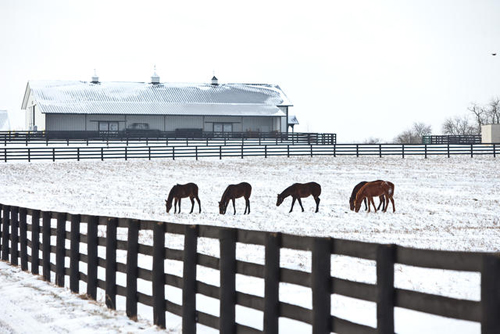Cold stress emergency coming up for livestock, pets
Cold stress emergency coming up for livestock, pets


Agricultural meteorologists from the University of Kentucky College of Agriculture warned that arctic cold is headed for the Bluegrass State.
“This is much colder air than we have seen the past couple of winters,” said Tom Priddy, UK agricultural meteorologist. “An Arctic air mass, coupled with north winds will create wind chills in the single digits at the start of next workweek. The single-digit wind chills, which may drop to near zero, will impact much of the area Monday night and Tuesday morning.”
Priddy said the combination of cold air and high winds could put most parts of Kentucky into periods of dangerous and emergency categories for livestock cold stress after the initial system passes through.
Livestock producers should make sure animals have adequate shelter, water, dry bedding and feed to make it through this cold spell. Pet owners should bring pets indoors. UK livestock specialists said animals have a higher requirement for energy in the colder months, so producers should have high-quality grains and forages on hand to meet their needs.
The average horse, with a lower activity level, should eat between 1.5 and 2 percent of its body weight in feed per day to maintain its weight. UK equine specialist Bob Coleman said that feed requirement goes up in the winter, as the horse uses more calories to keep warm. He recommended providing extra hay and making sure horses have shelter to get out of windy, damp weather. He said it’s also important for horses to have access to clean, unfrozen water.
Ambient temperatures can impact the amount of dry matter cattle eat, providing an opportunity to compensate for increased maintenance energy needs. Producers either need to increase their animals’ feed intake or increase the energy density of the diet by feeding higher quality hay or adding more grain or fat to the grain mix, said UK beef specialist Jeff Lehmkuhler.
Lehmkuhler recommended that producers continue to monitor cows during the wintertime and make sure to maintain the animals’ body condition.
“Poor quality hay may not provide adequate energy to maintain gestating cows that are entering the third trimester,” he said. “Consider having the hay tested to determine if you need to supplement during times of possible cold stress, especially for the enduring cold spells.”
He said to consider separating younger and thinner cows that may not have the same internal insulation as conditioned older cows and supplement them accordingly or offer them higher quality forage if available. Coleman said equine owners can employ similar strategies and separate animals according to body condition score.
“Producers should move cows to fields with natural windbreaks or provide man-made windbreaks, which are not the same as a barn,” Lehmkuhler suggested. “Poorly managed barns combined with poor ventilation may actually hamper efforts to improve the environmental conditions. Lastly, remember it is energy or calories that are really needed. If the protein level in the forage is adequate, do not make supplement decisions based on protein level; rather purchase the most affordable calories. Stay warm and keep the waterers flowing.”
The lower critical temperature (LCT) value for cattle is the lowest temperature or wind chill at which no additional energy is required to maintain core body temperature.
“As the temperature declines below this lower critical value, the maintenance energy value for the animal is increased to maintain core body temperature,” he said. “Animals maintain core body temperature by increasing their metabolism resulting in greater heat production, as well as other heat conservation strategies such as reducing blood flow to the extremities, shivering and increased intake.”
Lehmkuhler said several things can influence lower critical temperature value.
“Both external and internal insulation influences the LCT. External insulation is basically the depth and thickness of the hair coat, condition of the hair coat and thickness of the hide,” he said. “Thin-hided breeds such as dairy breeds tend to have a lower insulating factor than thick-hided breeds like Herefords. The condition of the hair coat is extremely important as an external insulation barrier.”
He explained the hair coat acts as insulation similar to home attic insulation that traps air, enhancing the insulating value. If the hair is wet and full of mud, air is excluded, reducing the insulating value and increasing heat loss from the skin to the environment. The density of the hair coat and if it is wet or dry impacts the wind chill temperatures at which cold stress is considered mild, moderate or severe. As little as 0.1 inch of rain can immediately impact cold stress severity by matting the hair down reducing its insulating ability. Acclimation time, hide thickness, fat cover and other factors will also influence the degree of cold stress that animals experience.
Weather


